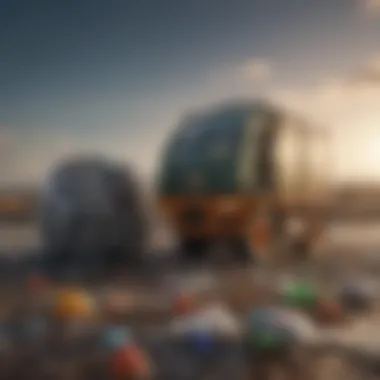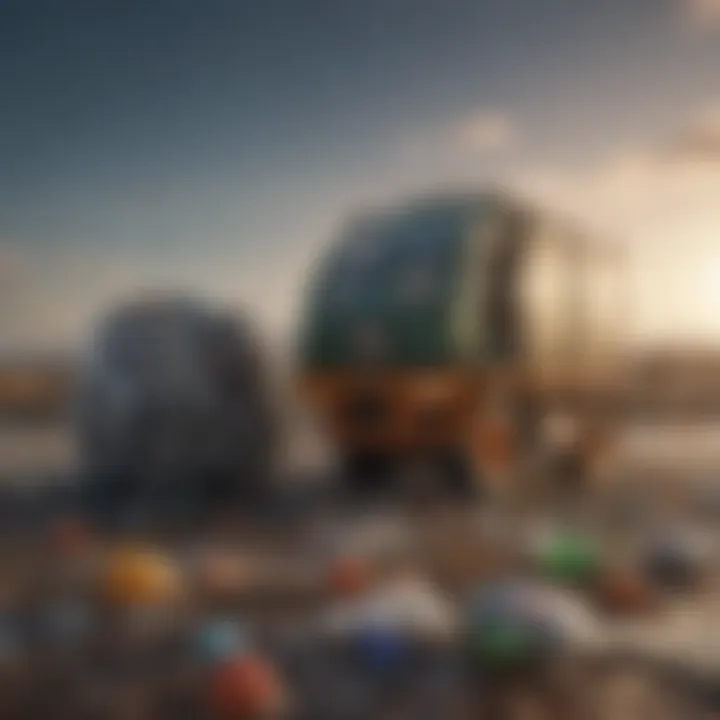Exploring the Environmental Consequences of Plastic


Intro
Plastics have woven their way into the very fabric of our daily lives, from the bags we carry to the bottles we drink from. Yet beneath this convenience lies a complex tapestry of ecological challenges. The prevalence of plastics in various forms—single-use items, microplastics, and packaging—contributes to a myriad of environmental dilemmas. These issues range from pollution of our oceans to the disruption of terrestrial ecosystems.
Understanding the full impact of plastics requires us to peel back the layers of production, disposal, and the socio-economic context surrounding plastic waste. As we dive deeper, it becomes evident that the implications of plastic usage stretch far beyond individual consumer choices and enter the realm of global environmental dynamics.
In this article, we will dissect how plastic permeates various ecosystems, examine its detrimental effects on wildlife, and contemplate the broader implications for human society and the economy. By exploring actionable solutions aimed at mitigating these issues, we hope to illuminate a path forward that prioritizes sustainability and ecological health.
Prelude to Plastic Pollution
The issue of plastic pollution has become impossible to ignore in recent decades. As the world produces over 300 million tons of plastic every year, the ramifications stretch wide and far – impacting everything from our health to the planet's delicate ecosystems. With single-use plastics flooding our global markets, understanding the rise and perils of plastic is crucial as we seek sustainable solutions.
Engaging with the concept of plastic pollution serves not just as an academic exercise, but as a vital exploration into the very fabric of modern life. Everyone, directly or indirectly, interacts with plastic daily, be it in packaging, clothing, or even household items.
Key considerations regarding plastic pollution include its types, disposal challenges, and the sheer volume that has accumulated in landfills, waterways, and oceans. The sheer scale of the issue necessitates not only awareness but urgent action among all stakeholders – from governments and corporations to individuals.
Importance of Understanding Plastic Types and Their Impacts
Knowing the various kinds of plastics, such as polyethylene and polystyrene, helps clarify their distinct behaviors in our environment. Moreover, evaluating the historical context of their use illuminates how we've reached this critical juncture. Surprisingly, the very materials that brought convenience also sowed the seeds of ecological distress.
"Plastic, once heralded as a miracle material, is now a ticking time bomb for our environment."
Delving deeper into the topic of plastic pollution reveals it as a multi-dimensional concern that affects not only the environment but also socio-economic factors. For instance, fishing communities grapple with the repercussions of plastic in oceans, directly affecting their livelihood. Understanding this intricate web of cause and effect lays the groundwork for actionable insights.
Through perceptive analysis, this section sets the stage for a more extensive conversation about the pervasive impact of plastics on our world. Addressing the root causes, acknowledging historical practices, and recognizing the variety of plastics helps frame this intricate problem. In the subsequent sections, we will delve into the lifecycle of plastic, scrutinize environmental repercussions, and explore potential solutions.
Production and Lifecycle of Plastic
The production and lifecycle of plastic are pivotal elements in understanding its environmental dynamics. This section illuminates how plastic is created, distributed, and consumed, revealing significant insights and challenges along the way. A comprehensive grasp of these topics is essential for educators, researchers, and students who seek to tackle the pressing issues related to plastic pollution.
Plastics are not merely products; they are the linchpin of various industries that have woven them into the very fabric of modern life. Their versatility and durability present certain benefits, yet the costs—both environmental and social—are substantial.
Raw Material Extraction
Extraction of raw materials for plastic production starts with fossil fuels, mainly petroleum. This process involves drilling deep into the earth's crust to find crude oil. The intricacies of this extraction can bear significant environmental consequences. For one, the process contributes to habitat destruction, often putting local wildlife at risk. Additionally, extracting these resources is energy-intensive, leading to emissions of greenhouse gases.
"The chaos of extraction not only ravages ecosystems but also impacts communities that depend on these lands."
Once crude oil is extracted, it needs to be transported, often via pipelines or tankers. These methods add another layer of risk. Spills can contaminate water sources and disrupt marine life. The extraction phase sets into motion a lifecycle that will challenge sustainability at almost every turn.
Manufacturing Processes
Once the raw materials are sourced, they undergo various manufacturing processes. These include polymerization and compounding, where the raw materials are transformed into plastic resins and mixed with additives to enhance characteristics like durability, color, and flexibility. Here, the energy demand continues to escalate. Factories emit pollutants that aggravate air quality and contribute to climate change.
Manufacturing plastic often generates waste products. Despite recycling capabilities, a significant fraction of plastic produced ends up in landfills. The relationship between plastic manufacturers and environmental regulations can complicate things further.
Distribution and Consumer Usage
Following manufacturing, plastic products enter the distribution phase. This stage requires complex logistics systems—from warehouses to retail environments. The transportation of these goods is another point where energy consumption peaks. Trucks, ships, and planes all contribute to the carbon footprint linked to plastic products.
Consumer usage brings its challenges as well. Plastics have embedded themselves deeply into everyday consumer behavior. Whether it's single-use bags or food containers, many people use plastics without a second thought. This ingrained habit leads to massive amounts of waste after just one use. It's not just about the products; it’s about the mindset that drives consumption.
As we can see, each step in the production and lifecycle of plastic bears weighty implications for the environment. By understanding these complexities, we equip ourselves to address the ongoing challenges posed by plastic pollution.
Environmental Repercussions
The ramifications of plastic pollution extend far into the environment, affecting soil, water, air, and ultimately, the delicate balance of ecosystems. Understanding these repercussions is vital for grasping the full scope of plastic's impact. A world inundated with plastics doesn't just affect aesthetics; it tangibly disrupts ecological processes. The intricate web of interactions among species and habitats begins to fray when contaminants seep into natural systems. Notably, this damage is not limited to the immediate surroundings of urban areas but propagates well beyond, influencing distant ecosystems and communities.
Soil and Water Contamination
Plastic does not simply disappear when discarded. Instead, it breaks into smaller and smaller particles, known as microplastics, which infiltrate soil and waterways. Studies indicate that these microplastics can alter soil composition and water quality, often with harmful effects on flora and fauna.
- Chemical Leaching: Plastics often contain harmful additives that can leach into the soil and water. These chemicals include bisphenol A (BPA) and phthalates, which have been linked to various health issues in wildlife and humans alike.
- Biodiversity Impact: Polluted soil may not support plant life as it once did, affecting organisms that rely on these plants for food and shelter. A cascade effect occurs, impacting entire food chains.


While many may consider this a distant problem, the reality is sobering.
"Every piece of plastic ever made still exists somewhere in our environment today."
Impact on Marine Life
The oceans, often seen as vast and uncaring bodies of water, are significantly affected by plastic pollution. Marine organisms mistake plastic debris for food, leading to ingestion that can have fatal consequences.
- Physical Harm: Animals like turtles, dolphins, and seabirds frequently consume plastic, resulting in starvation or internal injuries.
- Bioaccumulation of Toxins: Microplastics absorb toxic substances from the surrounding water. When marine animals eat these particles, toxins accumulate in their bodies, affecting their health and, ultimately, the effectiveness of the entire marine ecosystem.
- Species Decline: Certain species are declining due to the stress of plastic ingestion and entanglement, disrupting biodiversity and altering marine food webs.
Air Pollution from Production and Incineration
The journey of plastic from production to disposal contributes significantly to air pollution. Manufacturing processes for plastics are carbon-intensive, releasing greenhouse gases that exacerbate climate change.
- Processes Emissions: The extraction of fossil fuels and subsequent processing into plastics involves chemical reactions that emit various pollutants.
- Incineration Risks: While burning plastics might seem an effective disposal method, it releases toxic substances like dioxins and furans into the air, which pose serious health risks to nearby communities. Not only do these pollutants linger in the environment, but they can also enter the food chain through atmospheric deposition.
By examining these elements of environmental repercussions, it becomes clear that the impact of plastics reaches into a multitude of areas, warranting the urgent need for action and reform. Understanding how plastics influence soil, water, marine life, and air quality helps inform better policies and practices, paving the way towards sustainable solutions.
Effects on Biodiversity
The survival of our planet hinges significantly on the delicate balance of its ecosystems. Biodiversity, the variety of life in the world or in a particular habitat or ecosystem, is vital not only for aesthetic enjoyment but also for the resilience and productivity of our environments. The impacts of plastics on biodiversity is a crucial aspect of environmental dynamics that cannot be overlooked. The encroachment of plastic materials into natural habitats has far-reaching consequences, propelling species to the brink of extinction and disrupting habitats that countless organisms rely upon.
Threats to Species Survival
The threat that plastic poses to species survival is a reality that resonates across ecosystems from ocean depths to mountain tops. Numerous wildlife species ingest plastic debris, mistakenly identifying it as food. For instance, seabirds like the albatross have been documented feeding their chicks plastic items instead of nutritious prey. These plastics can cause internal injuries, starvation, and ultimately, death. One might say that plastic pollution is robbing birds of their very essence of nurturing and survival.
In a more terrestrial context, animals like deer or raccoons may encounter littered plastics while scavenging, leading to ingestions that have lethal outcomes. Additionally, marine life, including turtles, often mistake plastic bags for jellyfish, leading to tragic outcomes—the ramifications of which ripple through the food web.
The weakening of populations due to plastic ingestion isn't just a singular event. It's a domino effect; as certain species decline, those that rely on them for food may face challenges, resulting in a cascading loss of biodiversity. When the web of life is disrupted, ecosystems can collapse, leading to habitat loss for a myriad of other species.
Disruption of Ecosystems
The presence of plastic in ecosystems is not just a problem for individual species, but a malignant wound that disrupts entire ecological networks. Ecosystems function on interconnected relationships; a change in one part of the chain can send shockwaves through the rest. For example, the introduction of plastics into aquatic habitats can alter nutrient flows. Microplastics can change how nutrients cycle in water systems, affecting everything from bacteria to large fish species.
Additionally, plastics provide new surfaces for microorganisms to colonize, sometimes introducing harmful pathogens into environments that had previously been stable, leading to diseases that can decimate local populations of flora and fauna. Notably, species that are already vulnerable may find their numbers diminished, paving the path for invasive species to thrive, further complicating the balance.
"Understanding the threat of plastic pollution to biodiversity is critical—without the protection of diverse ecosystems, our own survival is inadvertently at stake."
The evening of the balance hinges on preservation efforts. The drastic need for reducing plastic outputs and enhancing habitat restoration is clear. Emphasizing the interrelations between species underlines the importance of tackling plastic pollution not just for the sake of the animals but ultimately for the health of our ecosystems. Collectively addressing these issues paves the way for a future where biodiversity can flourish, transcending the shadow of plastic's impact.
Climate Change Connection
Understanding the impact of plastics on climate change is crucial in today’s environmental discourse. The connection may not be immediately evident, but it is rooted in both the production of plastics and their role in atmospheric emissions. As climate change escalates, the implications of plastic pollution become even more dire.
Carbon Footprint of Plastics Manufacturing
The journey of plastic begins long before it reaches the hands of consumers. The manufacturing processes demand substantial energy, which often comes from fossil fuels. This reliance significantly contributes to greenhouse gas emissions. For instance, the production of polyethylene—a commonly used plastic—can release up to 2.5 tons of carbon dioxide for every ton produced. Moreover, extraction of raw materials like natural gas or petroleum involves drilling and refining, which leads to additional emissions and environmental degradation.
- Factors contributing to carbon emissions in plastic production:
- Extraction of fossil fuels
- Energy-intensive manufacturing processes
- Transportation of raw materials
The cumulative effect of these emissions not only perpetuates the cycle of climate change but also exacerbates air pollution in manufacturing regions. As communities contend with the dual burden of plastic pollution and worsening climate conditions, the intersection of these issues becomes harder to ignore.
Microplastics and Greenhouse Gases
As plastics degrade, they fragment into microplastics—tiny particles that have been found in various environments: oceans, soils, and even the air we breathe. While microplastics themselves are not greenhouse gases, their presence in ecosystems can indirectly contribute to climate issues. For example, they interfere with natural processes such as carbon sequestration by disrupting phytoplankton, which play a vital role in absorbing carbon dioxide from the atmosphere.
The alarming fact is that microplastics also absorb and release harmful greenhouse gases. This tug-of-war between microplastics and greenhouse gases adds another layer to an already complex climate challenge. Because these tiny particles can travel vast distances, their potential to affect global climate dynamics is significant.
The link between microplastics and climate change underscores an urgent need for comprehensive policies addressing plastic production and waste.
In summary, the connection between plastics and climate change is multifaceted, stemming from raw material extraction to the long-term effects of microplastics on carbon dynamics. As we grapple with the consequences of climate change, acknowledging and addressing the implicit role of plastics becomes essential for a sustainable future.


Socioeconomic Factors
Understanding the socioeconomic factors related to plastic pollution is essential when discussing the broader impacts of plastics on the environment. This section illustrates how the burden of plastic waste does not only affect nature but also intersects profoundly with economic structures and social dynamics.
Economic Costs of Plastic Waste Management
The financial implications tied to plastic waste are staggering. Handling plastic waste encompasses a range of processes – collection, sorting, recycling, and landfilling. According to some estimates, global expenditures on plastic waste management could exceed $400 billion annually. Local governments often feel the pinch the most, bearing costs of cleanup and disposal that may stretch their budgets thin. This cost can lead to increased taxation or service fees, causing a ripple effect that impacts households and businesses alike.
Some relevant points to consider include:
- Recycling Inefficiencies: Many recycling programs are not equipped to handle the volume of plastics produced, leading to high rates of contamination and insufficient recovery. This inefficiency can elevate costs, divert resources, and strain community efforts.
- Job Creation vs. Job Loss: While the recycling sector can create jobs, the transition from wasteful practices to sustainable solutions can lead to job losses in traditional manufacturing and waste management sectors.
- Health Costs: Inadequate plastic waste management can lead to health risks, further burdening healthcare systems with illnesses linked to plastic pollution, such as respiratory issues from burning waste or contamination from microplastics.
Impacts on Local Communities
Plastic pollution can particularly affect local communities, as these areas often bear the greatest brunt of waste management challenges. The outcomes can be multifaceted, touching everything from public health to social cohesion.
Some significant impacts include:
- Environmental Justice: Low-income neighborhoods often find themselves situated near waste disposal sites. The negative environmental health outcomes can lead to protest and community frustration. The lack of resources to handle plastic pollution can create disparities in health and well-being.
- Cultural Values: Communities that rely on healthy local ecosystems for fishing, recreation, or tourism see an erosion of quality of life and local culture. For instance, coastal areas suffer economically and socially as littered beaches deter tourists, impacting livelihoods.
- Community Initiatives: In many places, local responses can transform the narrative around plastic waste. Grassroots coalitions can arise, leading to educational programs on sustainable practices. Initiatives like beach clean-ups and awareness campaigns can not only tackle the waste issue but also strengthen community bonds, fostering a sense of activism.
In closing, recognizing the socioeconomic factors at play in plastic pollution highlights the intertwined fate of communities and the environment. Addressing these issues is not just an environmental necessity; it's a social and economic imperative that pivots around investment in sustainable practices.
Global Response to Plastic Pollution
Plastic pollution has rapidly escalated into a worldwide crisis. This section inspects the international, national, and grassroots responses shaped to tackle the growing dilemma. A unified response underscores the fact that plastic pollution knows no borders. Every stakeholder, from governments to local communities, plays a vital role in addressing this issue. The importance of understanding the responses is not just academic; it’s a call to rally together for a sustainable future.
"no single strategy can resolve the multitude of impacts created by plastic pollution, but blended strategies can create lasting change."
International Treaties and Agreements
Global cooperation is essential in combating plastic pollution effectively. Several international treaties and agreements have been established to promote sustainable practices and mitigate plastic waste. One notable example is the Basel Convention, which aims to reduce the movement of hazardous wastes, including certain types of plastics, between countries. Such agreements set the groundwork for penalties and accountability for pollution, but their effectiveness varies significantly based on enforcement.
Moreover, the United Nations Environment Programme (UNEP) organizes global dialogues and initiatives, like the Clean Seas Campaign, urging countries to commit to reducing plastic waste. Participation in these agreements often provides funding and support for developing nations, enabling them to enhance their waste management systems.
This collaborative framework strengthens global accountability while inspiring countries to create ambitious policies targeting plastic pollution and fostering a culture of sustainability internationally.
National Strategies and Policies
On the national level, many countries are crafting specific strategies to confront the issue of plastic waste. Various governments have enacted bans on single-use plastics, with countries like Rwanda leading the charge as one of the first nations to implement a nationwide ban on plastic bags. Nations like Canada and the European Union are also working to phase out certain types of plastics through stringent regulations.
These national policies are often backed by public campaigns emphasizing recycling and waste reduction, aiming to shift consumer behavior toward greener choices. Some governments are investing in infrastructure that facilitates improved waste management—sorting facilities and recycling plants—drawing on both public and private sectors.
Combining legislation with education campaigns, such as those run by Keep America Beautiful, encourages communities to engage in local clean-up initiatives. The synergistic approach of combining legislation, education, and community involvement is pivotal for creating tangible change.
Community Initiatives and Movements
At the grassroots level, communities are stepping up to take charge of their local plastic pollution crisis. Initiatives range from beach clean-ups organized by groups like Surfrider Foundation to innovative challenges urging residents to reduce daily plastic usage for an extended period. These local efforts often spill over into educational programs in schools, fostering a new generation of environmentally conscious individuals.
Community movements can also drive national policy, demonstrating the power of public opinion. For instance, the Plastic Free July movement encourages households worldwide to commit to avoiding plastics for a month, often resulting in long-term changes in habits.
These smaller-scale efforts, while seemingly localized, collectively create a ripple effect on broader legislation and societal norms regarding plastic consumption and disposal.
In essence, the global response to plastic pollution requires a multi-faceted approach, blending international treaties, national policies, and community actions. Each layer contributes to a more comprehensive strategy, reminding us that tackling this profound issue is a shared responsibility.
Innovative Solutions for Reducing Plastic Waste
The contemporary world is at a crossroads with plastic waste. As we grapple with the dire environmental effects stemming from plastic pollution, innovative solutions offer glimmers of hope. These solutions aim not only to mitigate the plastics crisis but also enhance sustainability practices across industries and communities. The emphasis here is on finding practical alternatives and advancements that lessen our reliance on conventional plastics, while also fostering a sense of responsibility in both consumers and producers alike.
Biodegradable Alternatives
In the quest to reduce plastic waste, biodegradable alternatives are rapidly gaining ground. These materials break down more naturally than traditional plastics, posing a lesser threat to ecosystems upon disposal. A prominent example lies in plant-based bioplastics. Crafted from renewable resources like corn starch or sugarcane, these bioplastics decompose under specific environmental conditions, significantly lowering their environmental footprint.
For instance, the production of bioplastics typically requires less fossil fuel compared to conventional plastics, reducing greenhouse gas emissions. While they still require careful disposal in industrial composting facilities, investing in infrastructure for such disposal methods is essential to realizing their benefits.


Overall, adopting biodegradable materials can be a game-changer, providing a pathway towards sustainable consumption, provided we also educate both manufacturers and consumers about proper usage and disposal mechanisms.
Recycling Technologies and Practices
The landscape of recycling is witnessing rapid advancement as new technologies emerge. Traditional recycling often suffers from inefficiencies or contamination issues, but innovations in recycling technologies promise to turn the tide on plastic waste.
One noteworthy development is the advent of advanced recycling. This process breaks down plastics back to their original monomers, allowing for the creation of brand new plastics that are of the same quality as virgin materials. Companies like Loop Industries are at the forefront of this technology, claiming that they can transform otherwise unrecyclable plastics into high-quality PET. This not only reduces waste but also diminishes the demand for virgin materials derived from petroleum.
Emerging practices such as deposit return schemes, where consumers receive refunds for returning plastic containers, also encourage responsible recycling. Such systems create a circular economy. Yet, awareness and ease of access to recycling facilities remain crucial—without these elements, even the best technological innovations can flounder.
Encouraging Consumer Responsibility
Ultimately, the success of any initiative aimed at reducing plastic waste hinges on consumer behavior. Educating the public about sustainable practices can foster a culture of responsibility. This ranges from simple habits like opting for reusable containers to advocating for systemic changes at local businesses.
Public awareness campaigns play a vital role in this educational drive. By tapping into social media platforms like Facebook and discussion sites like Reddit, stakeholders can generate conversations around sustainable practices. Visual campaigns can underscore the environmental cost of plastic waste—showing the stark contrast between a plastic-filled beach and a pristine one can spark emotional reactions and drive action.
Moreover, brands can tap into 'eco-friendly' marketing, pushing consumers towards choices that benefit the planet. Accessible guides on how to reduce plastic usage creatively, or certifications for genuinely sustainable products can guide concerned consumers.
"Consumer choices matter. Each item bought is a vote for the kind of world we wish to build."
Future Directions in Plastic Management
As we stand at a critical juncture regarding our planet’s health, it becomes increasingly vital to focus on the Future Directions in Plastic Management. This topic serves as a beacon of hope and responsibility, emphasizing innovative strategies that must be adopted to combat the overwhelming tide of plastic pollution. It’s not just about putting a band-aid on a gaping wound; rather, it’s about rethinking our relationship with plastics, their lifecycle, and our role in it.
Emerging Research and Innovations
Emerging research in the field of plastic management is brimming with promise and potential. From bioplastics derived from renewable resources to groundbreaking methods of plastic breakdown, scientists are tirelessly exploring ways to minimize dependency on conventional plastics. One noteworthy innovation is the development of enzymes that can digest plastics. These enzymes, often bred from microorganisms, could quite literally dissolve plastic waste at a faster rate than traditional recycling methods.
Furthermore, the rise of circular economy models is facilitating a shift toward sustainable practices in plastic usage. The concept advocates for creating closed-loop systems where plastic products are continuously reused or recycled, drastically reducing waste. For example, companies like Unilever and Coca-Cola are spearheading efforts to create packaging that can be repurposed indefinitely, ensuring that plastic does not see the end of its life in landfills.
There's no denying that new technologies are game-changers. For instance, a recent study highlighted by the Nature Sustainability journal showed how designing products for disassembly can significantly enhance recycling efficiency. By ensuring that components can be easily separated, the quality and quantity of recycled materials can improve, leading to a positive ripple effect in the environment.
Policy Recommendations for Sustainability
The role of policy in shaping the future of plastic management cannot be understated. Sound regulations are critical to enforcing sustainable practices and reducing plastic pollution at all levels. Policymakers should consider implementing stricter regulations on single-use plastics, encouraging businesses to innovate and pivot towards more sustainable alternatives. For example, a ban on plastic straws has been enacted in many municipalities, serving as a precedent that prompts further action.
Moreover, integrating incentives for manufacturers who participate in environmentally friendly practices could empower change. Tax reductions, grants for sustainable product development, or even recognition programs can motivate companies to think outside the box.
Education also holds the key to the future. It's imperative that policy promotes awareness campaigns that engage and educate the public on the impacts of plastic consumption and encourage responsible habits. For instance, initiatives focusing on community clean-up projects or sustainability workshops bring individuals together with a shared cause, fostering communal responsibility.
To sum up, the future of plastic management hinges on embracing emerging innovations and advocating for robust policies that prioritize sustainability. It’s about being proactive rather than reactive. As we journey forward, merging technological advancements with clever policy will not only mitigate the effects of plastic on our environment but also inspire a cultural shift towards a more sustainable world.
"We cannot solve our problems with the same thinking we used when we created them." – Albert Einstein
By addressing these intricate layers of plastic pollution, we carve a path to reclaiming the health of our ecosystems while fostering a future where plastics coexist with our environment in harmony.
End: The Path Forward
The topic of plastic pollution is not just an environmental issue but a complex web of interrelated consequences affecting our planet and its inhabitants. This article highlights the urgency of addressing plastic waste and its myriad impacts. From the production phase to the effects on ecosystems and human health, it is evident that a multifaceted approach is necessary to tackle the problem effectively.
Key elements that emerge from this discussion include the need for robust policy frameworks, innovative technologies, and enhanced public awareness. The environmental dynamics shaped by plastics are often overlooked, yet they bear significant implications for biodiversity, climate stability, and human wellbeing. By synthesizing findings from varied fields, we can propose more holistic solutions that consider both ecological integrity and socio-economic factors.
Summation of Key Findings
To recap, this article made several critical observations:
- Plastic pollution is pervasive: It impacts soil, air, and water quality, with damaging effects on living organisms.
- Biodiversity is under threat: Species extinction rates are accelerating, largely due to habitats disrupted by plastic waste.
- Plastic contributes to climate change: The carbon footprint associated with plastic manufacturing and degradation processes adds to greenhouse gas emissions.
- Economic implications are substantial: The costs associated with managing plastic waste burden local communities and governments.
- Innovative solutions exist: From biodegradable alternatives to advanced recycling technologies, numerous strategies can mitigate the crisis.
It is clear that without immediate action, these problems will compound, leading to irreversible damage not just to the environment but to society as a whole.
Call to Action for Diverse Stakeholders
Addressing plastic pollution requires a concerted effort from varied stakeholders, each playing a pivotal role. Some actionable steps could include:
- Governments: Implement stringent regulations on plastic production and foster initiatives for waste reduction. Transparent policies concerning environmental impact should be in place to hold companies accountable.
- Businesses: Innovate in sustainable practices. There is a pressing need for companies to re-evaluate their supply chains and find ways to minimize plastic use in production and packaging.
- Community groups: Grassroots movements can raise awareness and mobilize local actions, such as beach clean-ups or plastic-free campaigns. Engaging with educational programs can also reinforce the importance of reducing plastic consumption among citizens.
- Individuals: Make conscious choices about plastic use. Opt for reusable products and support brands committed to sustainability. Furthermore, spreading knowledge about plastic pollution can encourage collective action.
"If we work together, we can turn the tide on plastic pollution and safeguard our planet for future generations."
In summary, while the road ahead is daunting, the active involvement of all stakeholders can create a meaningful impact. We must foster a sense of urgency and responsibility, recognizing that each small action contributes to a larger narrative of change in our environmental dynamics.



